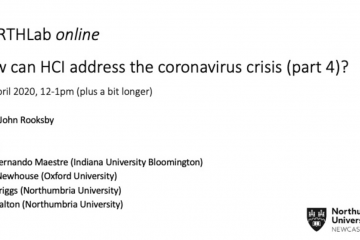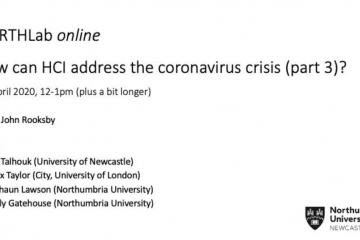Unfortunately I was unable to attend in real time the last of our NORTH Lab panels on covid-19 and HCI research (see summaries of panel 1, panel 2, panel 3 and panel 4), but thanks to technology I can still report back on what was discussed and make it look as if I was actually there! Except I will be responding in this post to people talking to me directly during the call 🙂 This time, we had three guest speakers who wrapped up the conversations on what HCI research(ers) can do for coronavirus.
First off is Mattias Rost – Hello to you Mattias and everyone else! 🙂
Dr Mattias Rost (university of Gothenburg) – Coders vs Corona
Nowadays, there are two truisms that stand in the tech world. 1. It’s never been easier to write software. With all tools we have available, we barely need to know how to write code to actually write code. 2. There’s never been as many software developers as there are now. You don’t even need a degree for it necessarily, you can take a 12-week course and become highly paid software developer.
With this pandemic hanging over our heads, everyone wants to help out in one way or another, regardless of skills. And developers are no different. There have been several hackathons organised: for example, in Sweden, Hack the Crisis attracted 7000+ people and had 537 entries. Northumbria’s Computer and Information Science department also had its own hackathon to help Flatten the Curve.
So what are software developers actually doing? Motivated by wanting to understand if there was a stand-out solution out there, Mattias looked through Github, a giant open source repository of code, to see what projects were available. After searching for ‘corona’, he looked at the top 100 repositories based on their star ratings, cleaned the data from any outliers and categorised it by purpose and what they were. He expected to find a bunch of trackers, graphs and visualisations of data, and perhaps some data modelling. What he actually found had some surprising elements:
Purpose:
Most repositories were about (i) showing numbers and tracking the virus, and (ii) making datasets available for other developers, aggregating it from various sources. Other types of repositories included things such as (iii) understanding the virus, so asking people to give away computational power to understand the virus, just like one would do when folding proteins. A handful were about (iv) self-reporting or (v) apps/services to share symptoms, or even (vi) simulating maps.
Type:
The majority of resources were (i) web-based solutions, followed by (ii) apps and (iii) repositories of data. Surprisingly, there were also a number of (iv) CLI tools – these were not created to model data, but rather to track the virus in some way.
It’s obvious from this analysis, that coders seem to want to make data available. Ultimately, one can argue that if we can see the data and increase awareness of it, it might help motivate us in staying at home and maintaining safe behaviours. But it’s also clear that code will not solve the pandemic.
So how can HCI research address corona crisis? Well, it’s hard to know. Software developers can do a lot, but alone they can’t go far. HCI researchers are good at doing multidisciplinary work and this is what we should be aiming for, perhaps working together with software developers to help them write good code for a good cause.
Of course, we need to be thinking about the quality of the codes produced. But there is perhaps value in doing these sorts of things even if just as a therapeutic practice, as a way of feeling like you’ve done something. Perhaps the code doesn’t get used or doesn’t have much value, but doing it can have value. It’s a bit like knitting… you may use the hat you knit, but the process of knitting will also be of value to you.
Dr Max Van Kleek (Oxford University) – What can HCI research do for Covid-19?
Picking on the last point above around the therapeutic nature of feeling as if we can actually do something, Max has been reflecting on the same question that our NORTH Lab sessions have been posing, i.e. what can HCI research do for covid-19?, as a means of processing what is happening and putting his skills and knowledge to good use. As HCI researchers, we are good at coming together and talking about things to try to solve real world problems.
In the last month or so, who hasn’t found themselves starting the day by reading the news and finding oneself being emotionally overwhelmed to the point that it’s hard to get own with our daily tasks? This is how Rasmus Nielsen, director of Reuters Institute, summarised his days. Rasmus is an expert on news media and how people consume news media and it’s clear that we are being hit by a flood of emotional pain. And more frustratingly, there’s seem to be nothing we can do about it. We are HCI researchers, we are not key workers – we can’t save lives, we can’t stalk shelves, we can’t help bring in vital supplies in the country.
So what can HCI researchers do?
As a field, we have informed the design of digital systems that are keeping society running. To us, this statement might seem obvious, but as Max reminds us, it’s important not to lose sight of this framing. Some of these systems are now critical in saving lives and when these systems fail or there are gaps, isn’t it our responsibility to identity the gaps? For the end users, these systems are so embedded in their routine and practices that people might not have the time and/or resources to actually step back and raise the issues. It’s our role to help, elicit from them what the challenges are and understand how to better design the systems.
For example, the newest Nightingale Hospital in London has recently announced they will be using a new electronic medical record, Cerner Millennium, and physicians have taken to YouTube to review the system and praise it. One doctor in particular was really proud of how efficient the systems was at allowing him to access patient information compared to others, yet if we examine it from a usability/UX point of view it’s a nightmare. It takes over 3 minutes to open the system and access a patient’s data. And that’s not accounting for any delays due to wearing PPE equipment. So, isn’t there scope for HCI researchers to think about how these systems could be better in the future?
Max raises three long-term discussion points and one more short-term.
LONGER TERM HCI ROLE:
- CSCW & working remotely
If you are a CSCW researchers, what we are living is now probably your best dream (or worst nightmare maybe!), because suddenly, everyone is now using remote work tools. We’ve been thrown into a massive experiment none of us asked for so we might as well reflect on what tools we are using and which ones we aren’t making much use of. And as this panel demonstrates, along with the online meeting fatigue most of us are experiencing, online conference systems are really being put to the test. But this is not really new – Douglas Engelbart’s Mother of all Demos came out in 1968. Has there been any real progress in collaborative tools since? Sure, especially things that we now take for granted, such as version control or concurrent editing. These tools really help us be more productive, whether we are colocated or remote. But there’s still loads of work that needs to be done!
One issue that needs tackling and that this pandemic has perhaps brought even more to the forefront for people, is low level human factors of remote work tools. For example, there’s a lot of bad psycho-acoustics, bad network traffic, exhaustion associated with online meetings. There’s also issues around lack of full-duplex direction, which makes it hard for turn-taking in any Zoom, Skype, Teams, you-name-it videoconference. Who is working in this space? Can we address poor accessibility/understandability? Instead of video conferencing software having filters to turn me into a rabbit or change my background, can’t we use this technology to do actual things to help. To this end, last week Google released a system WaveNetEQ which uses their deep neural networks to extrapolate what you are saying when packets are dropped. The system essentially infers what you are about to say and fills it in, raising a ton of ethical HCI and AI concerns.
There are also higher-level human factors of remote work tools that we have been investigating for a while in CSCW, particularly around synchronous colocated collaboration, and for which we haven’t even scratched the surface. For example, can VR and AR help improve the experience of remote meetings? How is it possible that groupware such as Microsoft Teams does not allow for better user experience, with hot keys for shortcuts for example? Is it going to take 20-40 years to solve these problems? Can we help steer the direction of the industry now?
- Information exposure effects, sensitivity & behaviour
Going back to Rasmus Nielsen’s summary of our daily experience of media consumption, we are constantly inundated with information, especially about constant loss and pain, both personal and non. This is then accompanied by fear, realising that even if you are young you are still at risk, or that vulnerable people are being left alone stranded with little to no support. And more recently we’ve been hit by wave of hopelessness and despair, because this period will mark the biggest recession in our lifetime, impacting our way of working for the foreseeable future. Being exposed to these three elements all the time will make us suffer even more. But do we have put ourselves through this? We know that we don’t all respond in the same way to information overload, fear and despair.
The sources of information used by people who are suffering more are the same used by people who are coping better. And on top of this, such tools are designed to exploit our weaknesses. As an example, recently Facebook told its advertisers that it could identify teens who felt insecure and worthless. As a result, Max calls for giving this up, because (quoted as requested 🙂 ) “We need to burn Facebook to the ground“, and start thinking of more ethical alternatives to deliver content, ways that are not just sensitive to people’s sensitivities, but also support them.
One of the students he’s working with, Claudine Tisman, has been working on a design fiction to explore what a different way of delivering information might look like, by wearing a radiation decimetre of tragedy or sadness.
First you (i) build a susceptibility profile; optionally you might (ii) work with a therapist to determine goals and devise an intervention plan; which then (iii) feeds into your information sources to (iv) curate content or way things are presented to achieve some sort of balance. This is then used to then (v) get emotional responses which are fed back, and finally allowing for (vi) transferable control, so the user is able to turn it on or off.
- Ethical data architectures
There’s lots of bad actors now who are benefitting massively from this lockdown, because priorities have shifted and instead of worrying about privacy we are preoccupied thinking about losing loved ones. Thus, even more so, our role as HCI is to identify any hazards and remove them, to allow people to get on with their caring responsibilities and concerns.
In the short term, as part of a Privacy & Cybersecurity house they run, Max and colleagues have been putting together a document that lists popular remote working/meeting tools and reviews their privacy and security policies.
SHORTER-TERM HCI ROLE:
- Lockdown exit strategy?
As a community, we need to weigh in our insights on various digital solutions that are being proposed as part of exit strategies. For example, we’ve probably all seen the contact tracing apps being rolled out to help notify others who have been in proximity of someone infected. However, there is little consideration of the human-factors aspects for these systems. Some have privacy-by-design build in, some have overt privacy challenges – and users don’t necessarily know the difference. These systems are also built on a number of assumptions which are actually quite challenging, such as that 60% or more of the population will install and use the app effectively.
In order to have the most impact in the short-term when weighing on exit strategies, such as informing contact tracing apps, we need to be more heavily involved from the beginning. Sticking with the example of contact tracing apps, these solutions are often designed by cryptographers, modelled on cybersecurity models, with unrealistic and optimistic assumptions of human behaviour. As HCI researchers, we should help them unpack these assumptions and help them understand human behaviours, as well as liaise with various experts, even within our field, such as Health HCI researchers.
Dr Leysan Nurgalieva (Trinity College Dublin) – Sharing personal health information when being monitored
As a great follow-on from Max’s talk, Leysan presented her reflections from her own work looking at views on privacy concerns and sharing strategies in tenants of age care facilities in the US and Italy.
There’s been a lot of discussions around trade-offs recently, for example between saving lives and saving economy, or slowing the spread of the virus and persevering citizen freedom and privacy. And to the last point, as Max pointed out with the contact tracing apps, governments have been trying to track citizens at different degrees, and this has been generally an accepted practice.
Drawing some parallels with her research, Leysan reflected on older adults who live in independent living facilities, where they still preserve some independence but are also being monitored as a by-product of moving into these facilities, to feel safer and looked after. What she found was that in some situations, their privacy is more compromised than would like to, although some circumstances still make it acceptable, such as in instances of critical health. Other times, older adults wanted to avoid being monitored, and did so by fooling the system.
Privacy concerns and blind spots
- Lack of transparency about information gathering and inability to control it
- Aggregation of personal information from multiple sources and concerns on its usage
- Misconceptions: information flows, data persistence, ‘nothing to hide’
- Sources of information on risks, linking back to Santosh’s talk on fake news
- Inefficient mitigation strategies, i.e. believing that certain actions will preserve your privacy
Sharing strategies in aged care
Sharing information was dependent on five dimensions of strategies:
- Who the recipients were?
- Purpose, whether it was desirable or not
- Data and its nature (relevance, urgency, granularity)
- Delivery, both in terms of frequency and channel
- Individual attitudes, around feeling in control, emotional responses and views on privacy issues
From this we can see that trends that were here before the pandemic, are still here. So what parallels can be drawn? There are at least three open questions that arise:
- Awareness and education programs and leveraging existing points of contact for outreach. How can we distribute information in a clearer way?
- Supposedly short term nature of privacy infringements. Can we use design to make sure short terms needs to not lead to long term privacy violations?
- Moving to more digital and remote healthcare. What will this mean for online privacy? What are the privacy requirement for these systems when they are built? Security is more recognised as critical and a functional requirement, but privacy is not as clear.



0 Comments